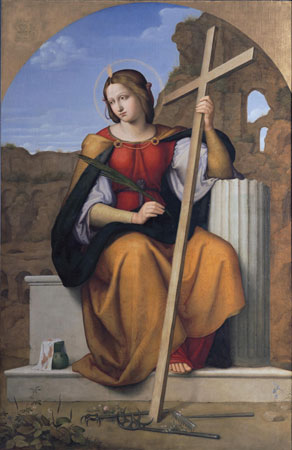Johann Heinrich Ferdinand Von Olivier
Born Dessau, 1 April 1785 - Died Munich 11 Feb 1841.
Johann Heinrich Ferdinand Von Olivier was a painter, draughtsman and lithographer, brother of Heinrich Olivier. The brothers’ mother was a court opera singer in Dessau, and Ferdinand’s later interest in the German medieval and Nazarene styles owed much to the intellectual climate at the Anhalt-Dessau court, where Leopold III Frederick Francis, Prince of Anhalt-Dessau, had been the first German prince to introduce the Gothic Revival style.
Olivier took up drawing in 1801–2 under the tuition of Carl Wilhelm Kolbe and the engraver Johann Christian Haldenwang (1777–1831).
In 1802–3 he accompanied his father to Berlin, where he studied woodcut techniques under Johann Friedrich Gottlieb Unger (1755–1804) and may have attended August Wilhelm Schlegel’s lectures on belles-lettres and art. It was here, at the latest, that he discovered Herzensergiessungen eines kunstliebenden Klosterbruders (Berlin, 1797) by Wilhelm Heinrich Wackenroder and Ludwig Tieck, and the latter’s Franz Sternbalds Wanderungen (Berlin, 1798), two books of vital significance for the painting of the Romantic era.
Having decided to make art their career, Ferdinand and his brother Heinrich spent two years (1804–6) in Dresden, where they copied the works of Ruisdael and Claude Lorrain in the art gallery during the summer months. Ferdinand also took lessons from Jacob Wilhelm Mechau (1745–1808) and Carl Ludwig Kaaz, both painters of idealized landscapes, and he was probably introduced to the work of Philipp Otto Runge and Caspar David Friedrich by Friedrich August von Klinkowström (1778–1835), a friend of Runge.
In June 1807 Ferdinand’s excellent knowledge of French led to his appointment as embassy secretary in Paris, where Heinrich soon joined him. However, after just a few weeks he gave up his diplomatic career in order to devote himself to a study of the Musée Napoléon, which at that time housed art treasures pillaged from all parts of Europe. Ferdinand and Heinrich jointly produced three paintings for Leopold III Frederick Francis of Anhalt-Dessau: a portrait of Napoleon on Horseback (c.1809; Wörlitz, Schloss), and a Last Supper and Baptism (1809–10; Wörlitz, Evangel. Ch.) for the Gothic Revival church in Wörlitz. Although these last two were supposed to be copies after the ‘old German school’, the Olivier brothers in fact used 15th- and 16th-century Dutch and Flemish models to create original compositions.
At the end of 1809 they returned to Dessau. In 1810, on a tour of the Harz with his younger brother Friedrich Olivier, Ferdinand produced a number of markedly naturalistic sketches that testify to the break with his schooling in Dresden, for example Cliffs on the Brocken (1810; Dessau, Anhalt. Gemäldegal.).
In 1811 he travelled with Friedrich via Dresden to Vienna where the Lukasbrüder had been formed shortly before. Although the group had since moved to Rome, the Olivier brothers soon became acquainted with its ideals through Philipp Veit, Friedrich von Schlegel’s stepson, whose home they frequented, and Joseph Sutter (1781–1866).
In 1817, with Julius Schnorr von Carolsfeld, they were accepted—from afar—into the Lukasbrüder.
Paintings by Johann Heinrich Ferdinand Von Olivier
View of Salzburg - 1818
Meadow - 1823
Elijah in the Wilderness - 1831
Babylonian Landscape - Date Unknown
Jesus on a Stroll - Date Unknown
Landscape I - Date Unknown
Landscape II - Date Unknown
The Family of Johannesknaben - Date Unknown

Philipp Veit
Born Berlin, 13 Feb 1793 - Died Mainz, 18 Dec 1877.
Philipp Veit was a German painter. He was the stepson, from 1804, of Friedrich von Schlegel, he studied (1808–11) at the Akademie in Dresden under Friedrich Matthäi (1777–1845) and Caspar David Friedrich.
He showed talent in drawing but, on moving to Vienna in 1811, had difficulties with painting in oil, and turned to watercolour. Through Schlegel, Veit came to know many of the leading Romantics in Vienna, such as the poet and novelist Joseph von Eichendorff.
In 1813–14 Veit took part in the campaign against Napoleon and returned briefly to Berlin.
In 1815 he completed a votive picture, the Virgin with Christ and St John, for the church of St James in Heiligenstadt, Vienna, inspired by the work of Pietro Perugino and Raphael.
In 1815 Veit left for Italy where he stayed until 1830. In Rome he joined the circle around Friedrich Overbeck and Peter Cornelius, becoming a leading Nazarene. With these artists he took part in providing fresco decorations (1816–17) for the Casa Bartholdy (now the Bibliotheca Hertziana): Veit painted the scene of Joseph and Potiphar’s Wife and a decorative lunette allegory, the Seven Years of Plenty (both now Berlin, Staatl. Mussen, N.G.).
In 1818 Veit was commissioned to paint the fresco of the Triumph of Religion in the Museo Chiaramonti in the Vatican, one of a series of murals recording the services of Pope Pius VII to science and art. Veit also took part in the decoration of the Casino Massimo in Rome (1818–24), painting the ceiling of the Dante Room with the Heavens of the Blessed and the Empyrean. In these frescoes and in his Maria Immaculata in Trinità dei Monti (1829–30) Veit proved himself the finest colourist of the Nazarene artists. While in Rome, Veit also painted some excellent portraits, notably a Self-portrait (c. 1816; Mainz, Landesmus.). He also produced a fine series of pencil drawings of his fellow German artists in Rome (e.g. Mainz, Landesmus.).
Paintings by Philipp Veit
Joseph and Potiphar's Wife - 1817
Ecce Homo - 1819
The Rest on the Flight - 1840
St. Anne Teaching the Virgin to Read - 1869
Germania I - Date Unknown
Germania II - Date Unknown
Italia - Date Unknown
Religion Chiaramonti Fresco - Date Unknown